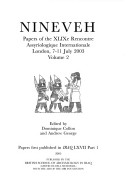The XLIXe Rencontre Assyriologique Internationale convened in London to celebrate the British Museum's quarter millennium. Nineveh, the last great imperial capital of the Assyrian Empire, was a topic well suited to the occasion. On the museum's behalf excavations were conducted at the site intermittently for more than 80 years, from 1847 to 1932. The attractive bas-reliefs that adorned the palaces of Sennacherib and Ashurbanipal have become some of the museum's most familiar exhibits. The vast numbers of clay tablets sent back from Nineveh by Austen Henry Layard and his successors are less eye-catching but remain the cornerstone of almost all Assyriological research. But there is more to Nineveh than an imperial city of the seventh century B.C. Mallowan's famous deep sounding of 1931-32 took the history of the settlement back another five thousand years. More recent research has collected evidence for the city's history in the post-Assyrian periods. Looking beyond the local horizons, the renown of Nineveh as an important city survived the end of ancient Mesopotamian civilisation in the literary and historical traditions of the Greeks and the Bible. The proceedings of RAI 49 comprise a wide range of papers on Nineveh and form an invaluable and well-informed academic resource for future research on the city itself and the civilisation that built it.
- ISBN10 090347218X
- ISBN13 9780903472180
- Publish Date 10 October 2005
- Publish Status Active
- Publish Country GB
- Imprint The British School of Archaeology in Iraq
- Format Paperback
- Pages 427
- Language English
